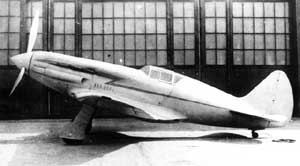Mikoyan-Gurevich MiG-1
| MiG-1 | |
|---|---|
 |
|
| Role | Fighter/interceptor |
| Manufacturer | Mikoyan-Gurevich |
| First flight | 5 April 1940 |
| Retired | 1944 |
| Primary user | VVS |
| Produced | 1940 |
| Number built | 100 + 3 prototypes |
| Variants | Mikoyan-Gurevich MiG-3 |
The Mikoyan-Gurevich MiG-1 (Микоян-Гуревич МиГ-1) was a Soviet fighter aircraft of World War II that was designed to meet a requirement for a high-altitude fighter issued in 1939. To minimize demand on strategic materials such as aluminum, the aircraft was mostly constructed from steel tubing and wood. Flight testing revealed a number of deficiencies, but it was ordered into production before they could be fixed. Although difficult to handle, one hundred were built before the design was modified into the MiG-3. The aircraft was issued to fighter regiments of the Soviet Air Forces (VVS) in 1941, but most were apparently destroyed during the opening days of Operation Barbarossa, the German invasion of the Soviet Union in June 1941.
The MiG-1 was designed in response to a requirement for a high-altitude fighter with an inline engine issued by the VVS in January 1939. Initially the aircraft, designated I-200, was designed in the Polikarpov construction bureau. Work started in June 1939, under the direction of Nikolai Polikarpov and his assistant M. Tetivikin. Polikarpov himself preferred radial engines and promoted his I-180 design at that time, but when the powerful Mikulin AM-37 inline engine became available, he decided to use it in a fighter. The approach that he selected was to build the smallest possible aircraft around the intended powerplant, thereby minimizing weight and drag — the philosophy of the light fighter. As specified, the aircraft was to be capable of reaching 670 km/h (417 mph). In August 1939, Polikarpov fell out of favor with Joseph Stalin and as a result, when Polikarpov went in November 1939 to tour Germany's aviation works, the Soviet authorities decided to scatter his construction team and create a new Experimental Construction Section (OKO), headed by Artem Mikoyan and Mikhail Gurevich, which remained formally subordinated to the Polikarpov bureau until June 1940. Further work upon the I-200 design was assigned to Mikoyan and Gurevich, who later became recognized — not with full justice — as its designers.
...
Wikipedia
